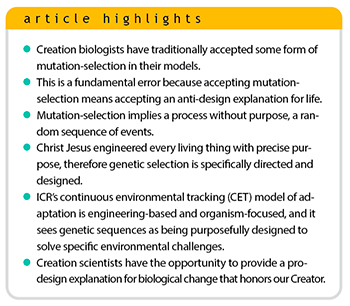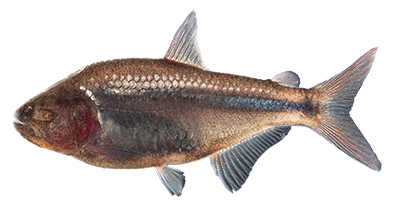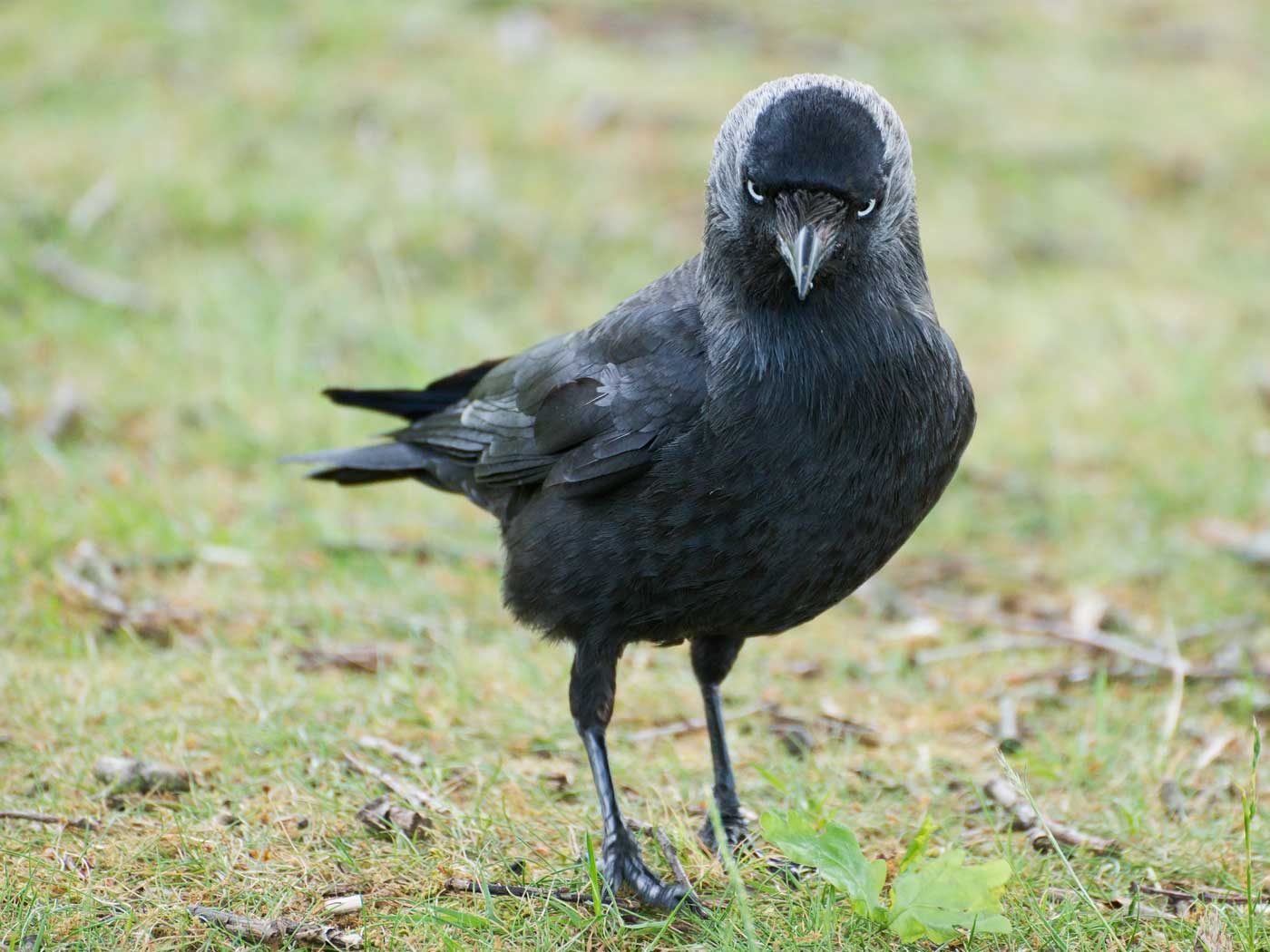 Creation scientists sometimes say to evolutionists, “We have the same data you do, but we have different interpretations.” That statement is definitely true of the different approaches to geology. Interpreting geological features as artifacts of a global, yearlong flood differs radically from the conventional belief that present geological processes are the key to understanding the past.
Creation scientists sometimes say to evolutionists, “We have the same data you do, but we have different interpretations.” That statement is definitely true of the different approaches to geology. Interpreting geological features as artifacts of a global, yearlong flood differs radically from the conventional belief that present geological processes are the key to understanding the past.
But it isn’t true that creationists have historically interpreted biological adaptation differently than Darwinists. We’ve almost always assented to the Darwinian mechanism of mutation and selection. Sure, we’ve tacked on some disclaimers that while mutation-selection is true, it’s limited. We’ve added more disclaimers to force-fit it into a biblically inconsistent explanation. This jury-rigging of our explanation should be a wake-up call that we’re way off base. The fact is that creationists have been playing Darwin’s game, on his field, by his rules.
For instance, when it comes to the extraordinary biological changes observed in finch beaks, flightless birds on islands, or even peppered moths, creation scientists have historically failed to provide a biblically consistent and scientifically sensible alternate explanation for them—or even a new hypothesis. For decades, we’ve interpreted things like the loss of eyes in cavefish by applying the same ill-conceived, scientifically foolish narrative gloss of random genetic mutations that are mystically acted on by Darwin’s conception of natural selection.
Somehow, we’ve believed that we could tack on something like “but all Darwin shows is a loss of eyes (i.e., information) and not the evolution of eyes” and thus conform our thinking wholly to the Darwinian mechanism while fortuitously escaping the anti-theistic effects of its thinking. But we haven’t escaped. By playing Darwin’s game, we compromise biblical truth and impede scientific research. We can’t refute the Darwinian explanation of adaptative change because we’re saying the same thing.
How Does Evolution Tend Toward Atheism?
Ask yourself how evolutionary thinking tends toward atheism. Once pinpointed, an anti-biological design to anti-theistic connection is obvious. Evolutionists excel at swaying people to believe a counterintuitive anti-design view of biological adaptation. Accepting their mutation-selection view tends to move people from a general belief in God—acknowledged by even the famed evolutionist Richard Dawkins—to an atheistic destination. Though an atheist, Dawkins grants that
We are entirely accustomed to the idea that complex elegance is an indicator of premeditated crafted design. This is probably the most powerful reason for the belief, held by the vast majority of people that have ever lived, in some kind of supernatural Deity.1
Remarkably, though, people’s prior perceptions are radically transformed after embracing a key evolutionary assumption—random, purposeless adaptation, as embodied by the Darwinian mutation-selection approach to biology. Although many theistic selectionists miss it, the late philosopher Bertrand Russell recognized exactly what mutation-selection implies, saying:
But even more purposeless, more void of meaning, is the world which Science presents for our belief…that Man is the product of causes which had no prevision of the end they were achieving; that his origin, his growth, his hopes and fears, his loves and his beliefs, are but the outcome of accidental collocations of atoms….A strange mystery it is that Nature, omnipotent but blind, in the revolutions of her secular hurryings through the abysses of space, has brought forth…[mankind] with the capacity of judging all the works of his unthinking Mother.2
How does Darwinism move people from their intuitive thoughts that creatures are “premeditated crafted design” by God to believing that they are just purposeless outcomes of “Mother Nature”? We need to peel off some layers to see how the Darwinian mutation-selection mechanism fills that bill.
We begin by recognizing that from a biblical perspective, any theory starting with the assumption that creatures weren’t designed is anti-theistic. How, then, is mutation-selection inherently anti-design and thus anti-theistic? As Russell summed up, it introduces the notion that organisms are produced in such a haphazard, accidental, and thoughtless way that it persuades a person to conclude that no rational engineer (i.e., God) would ever have had a hand in it. Once people accept that anti-design processes can produce creatures, then they’re pointed toward atheism.
Purposeless Mutation: The Segue to Anti-Design Thinking
The goal of Darwinism has always been to explain the design of living things without recourse to a supernatural Designer. The renowned evolutionist Francisco Ayala explained:
The conundrum faced by Darwin can hardly be overestimated. The strength of the argument from design to demonstrate the role of the Creator had been forcefully set forth by philosophers and theologians. Wherever there is function or design, we look for its author. It was Darwin’s greatest accomplishment to show that the complex organization and functionality of living beings can be explained as the result of a natural process—natural selection—without any need to resort to a Creator or other external agent.3
The anti-theistic power of Darwinism lies in one thing only—its anti-engineering assumptions. A classical Darwinian mechanism for adaptive change must use words that convey anti-design characteristics. Why? Well, if scientific literature can persuade people that organisms came about via a chaotic, purposeless process, then this fact would negate God directly creating them, and Darwinism would seem to make more causal sense.
The evidence for the vital anti-design themes of randomness and purposelessness emerges in what evolutionists themselves repeatedly say are core beliefs essential to Darwinian thinking. Beginning with anti-engineering assumptions and an anti-design goal, evolutionists interpret the genetic changes they observe with words that express the opposite of what a real engineer would do. Selectionist literature constantly instills anti-design thoughts through descriptive words like random, accidental, broken, non-controlled, purposeless, etc.
Several evolutionary theorists explain why anti-design is a non-negotiable axiom or deeply embedded core tenet.
The random occurrence of mutations with respect to their consequences is an axiom upon which much of biology and evolutionary theory rests. This simple proposition has had profound effects on models of evolution developed since the modern synthesis, shaping how biologists have thought about and studied genetic diversity over the past century.4
The core tenet of the MS [modern synthesis, or current evolutionary theory] is that adaptive evolution is due to natural selection acting on heritable variability that originates through accidental changes in the genetic material. Such mutations are random in the sense that they arise without reference to their advantages or disadvantages.5
Evolutionary theory asserts that adaptive mutations, which improve cellular fitness in challenging environments, occur at random and cannot be controlled by the cell….The assertion that adaptation occurs purely through natural selection of random mutations is deeply embedded in our understanding of evolution.6
A classical or Darwinian evolutionary system embodies a basic principle: purposeless genetic variation of reproductive individuals, united by common descent, coupled with…natural selection of those rare individuals that fortuitously express the traits that complement or thwart the contemporary selective pressures….It’s a process replete with chance.7
How do these words instill an anti-engineering view of biology? It’s because neither the engineering design process nor its products are random, accidental, broken, trial-and-error, non-controlled, purposeless, and the like. All of the anti-design thoughts conveyed by these words are summed up in the mutation-selection mechanism in just one word—mutation. Consider this: what anti-theistic power would the mutation-selection mechanism have if the word mutation were replaced with “directed genetic change”? The anti-theistic thrust would vanish.
The anti-design framework expects non-purposeful changes to genes, and interpretations are colored thereby. So, when selectionists see a change in DNA (or traits), they mechanically label it a random mutation. But, it must be emphasized that these labels do not reflect observation-based descriptions. Selectionists don’t have tests to demonstrate that these genetic changes are random, or even that the genes are broken. These are merely anti-design characterizations of genetic change—strictly a narrative gloss—that are drilled into biologists from their earliest days of training. The vast majority of evolutionary biologists would adamantly maintain that genetic changes are undeniably purposeless, undirected mistakes. They cannot comprehend—or countenance—biology operating in any other way.
Blind Cavefish: Creationists Have Adopted Darwinism

Regrettably, most creationists and Intelligent Design advocates also couldn’t fathom biological adaptation happening in any other way. So, we’d publicly endorse the Darwinian mechanism of randomly occurring broken genes that are “worked on” by Darwin’s concept of natural selection (i.e., passive creatures being shaped by “selection pressures”).
A prime illustration is the exhibit describing the origin of cavefish displayed in ICR’s original creation museum in Santee, California.8
As genetic information is copied and passed on generation after generation, occasionally there are copying “mistakes” known as mutations. Mutations have been observed to destroy, damage, or corrupt genetic information or to be neutral, but have never been observed to add new information. This is true even of so-called “beneficial” mutations that may be advantageous to the surviving organism in some circumstances….When a mutation occurs in a light environment that causes animals’ offspring not to have eyes, it is an enormous disadvantage…so natural selection eliminates this flaw….When the eyeless defect occurs here [in a cave], it does not give any disadvantage so it is not eliminated. In fact, it gives advantages. Those with eyes can crash into things, injuring the eyes, and can get diseases of the eyes, possibly leading to death….Eventually, selective pressures ensure that all are eyeless….These ghostly fish [are] prime examples of how mutation and natural selection lead to a reduction of functioning systems….These adaptations are no evidence at all for the belief that complexity has arisen by such processes—they only show how information can be lost in a fallen world.
In sum, creationists also claim that surface-dwelling ancestors gradually morphed into cave-dwelling forms due to random genetic mutations that result in a loss of information through a purposeless, trial-and-error process of death and survival (i.e., natural selection) that produces depigmentation and blindness. Selection pressures ensure that all are eyeless.
What’s usually missed is that both the non-evolutionary and evolutionary interpretations are identical. Both invoke the mutation-selection mechanism. Two problems arise. First, creationists use the same words and thoughts conveying the anti-design assumptions vital to evolutionary theory. Next, and this may shake Acts & Facts readers to the core, essentially every assertion in our old explanation has been shown to be scientifically untrue.
Consider another example of two statements describing how biological adaptation occurs. One is made by the vehemently anti-design atheist Massimo Pigliucci. The other was published in a creationist journal reflecting what I thoughtlessly repeated for years. Which one is Pigliucci’s?
- “All organisms share common descent and are adapted to the environment through natural selection.”
- “Every organism [descends from ancestors] and natural selection has acted upon ancestral variation and de novo mutations to adapt them to changing environments.”
The thoughts these statements share are: no foresight, random broken genes, gradual change, active environments adapting passive organisms (e.g., “adapt them to”) “acted on” by Darwinian selection—and no hint of a designed, purposeful process. Statement one is Pigliucci’s.9 Therefore, the statement that creationists have the same data but have different interpretations isn’t really true in this case.
Don’t Play Darwin’s Game; Develop a New Theory
Everyone knows that engineers don’t produce designs in a purposeless, chaotic fashion. But, if the status of “true science” is retained for the evolutionary scenario that randomness and mistakes truly can cobble together living organisms, then people will continually be persuaded away from accepting that creatures originated from a supernatural engineer called God.
Creation scientists have been doing a disservice to fellow believers. We’ve been teaching that the Darwinian mutation-selection mechanism is real but just limited in effect, and that evolutionists’ error is claiming that its effect is nearly unlimited. This has been a colossal mistake. The evidence from the mouths of evolutionary theorists is that key assumptions epitomized in mutation-selection itself are the segue to anti-design and thus are anti-theistic assumptions.
At ICR, we greatly regret ever having endorsed the mutation-selection mechanism. When you stop to think about it, that whole notion of a chaotic mechanism for adaptation is inconsistent with all the other incredibly complex and purposeful biological systems the Lord Jesus created.
We compromised creationist thinking with Darwin’s death-driven worldview by using the phrase “for this fallen world” as our own segue to accommodate the misery associated with mutation-selection in our model of adaptation and to advance our lighter version of evolution—theistic selectionism. Worse, some of our museum displays even taught that it was God who ordained mutation-selection “as a conservative mechanism” to cull animals or people with genetic defects from the “gene pool” for the benefit of the rest. Mutation-selection derailed us into looking to the Fall and not to creation for biblical insights about adaptation. Why wouldn’t the original purposeful, orderly adaptation mechanisms that the Lord built into creatures still be the principal mechanisms in operation today?
From a scientific standpoint, our explanations about fish eyes getting scratched in caves and birds being blown off islands until mutation-selection made them all flightless are as ridiculous as any other evolutionary story. Our most important mistake was accepting that a whole suite of changes associated with life in a cave resulted from random, broken genes. This was also absurd. Many would be shocked to know that for about two decades, there have been so many scientific papers pointing to directed genetic changes toward purposeful ends that books have been written about them. The whole random mutation idea—so foundational to Darwinism’s anti-design premise for adaptation—is falling apart.
Since creationists weren’t considering anything other than mutation-selection, we weren’t even thinking about built-in mechanisms conferring multigenerational adaptative abilities. We claimed that creatures were intelligently designed, yet our fixation on mutation-selection inhibited us from thinking about integrating engineering principles into models of biological systems.
This is why ICR’s continuous environmental tracking (CET) model of adaptation is so liberating. It’s the first engineering-based, organism-focused model that interprets altered genetic sequences as purposeful modifications and not broken genes, and as regulated changes rather than random mutations. It views such sequences as being targeted to intentionally bring about rapid and predictable adaptations in order to solve specific environmental challenges. ICR’s experiments on blind cavefish are confirming our pro-design assumptions.
Perceptive evolutionists know that the true victory resides in people embracing their anti-design mechanism. Once everyone is playing their anti-design game, on their anti-design field, by their anti-design rules, then they’ve already won and we’ve lost—no matter how many caveats or disclaimers we attach.
Playing Darwin’s game only pits creationists against evolutionists in a highly subjective squabble over what mutation-selection can accomplish—and without them even considering whether it’s true or dishonors the Lord Jesus. Creationists have an opportunity to provide a pro-design and far more Christ-honoring and scientifically accurate explanation of biological change...if we’ll just pursue it.
References
- Dawkins, R. 1986. The Blind Watchmaker. New York: Norton, xii.
- Russell, B. 2008. A Free Man’s Worship. The Meaning of Life. E. D. Klemke and S. Cahn, eds. Oxford: Oxford University Press.
- Ayala, F. J. 2007. Darwin’s greatest discovery: Design without designer. Proceedings of the National Academy of Sciences. 104 (suppl. 1): 8567-8573.
- Monroe, J. G. et al. 2022. Mutation bias reflects natural selection in Arabidopsis thaliana. Nature. 602: 101-105. Referencing Futuyma, D. J. 1986. Evolutionary Biology, 2nd ed. Sunderland, MA: Sinauer Associates.
- Charlesworth, D., N. H. Barton, and B. Charlesworth. 2017. The sources of adaptive variation. Proceedings of the Royal Society B. 284 (1855): 20162864.
- Hull, R. M. et al. 2017. Environmental change drives accelerated adaptation through stimulated copy number variation. PLoS Biology. 15 (6): e2001333.
- Greaves, M. and C. C. Maley. 2012. Clonal Evolution in Cancer. Nature. 481: 306-313.
- This explanation is still featured in The Creation and Earth History Museum, which was established after ICR’s move to Texas when the ICR museum and its contents were sold.
- Pigliucci, M. 2008. Is evolvability evolvable? Nature Reviews Genetics. 9: 75-82.
* Dr. Guliuzza is President of the Institute for Creation Research. He earned his Doctor of Medicine from the University of Minnesota, his Master of Public Health from Harvard University, and served in the U.S. Air Force as 28th Bomb Wing Flight Surgeon and Chief of Aerospace Medicine. Dr. Guliuzza is also a registered Professional Engineer and holds a B.A. in theology from Moody Bible Institute.





















